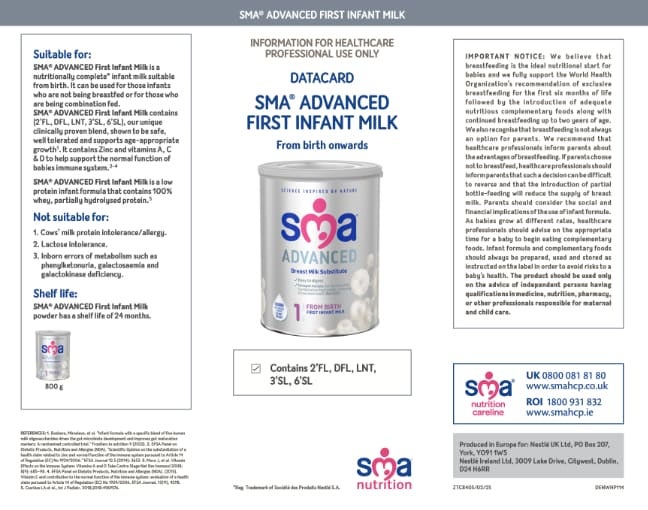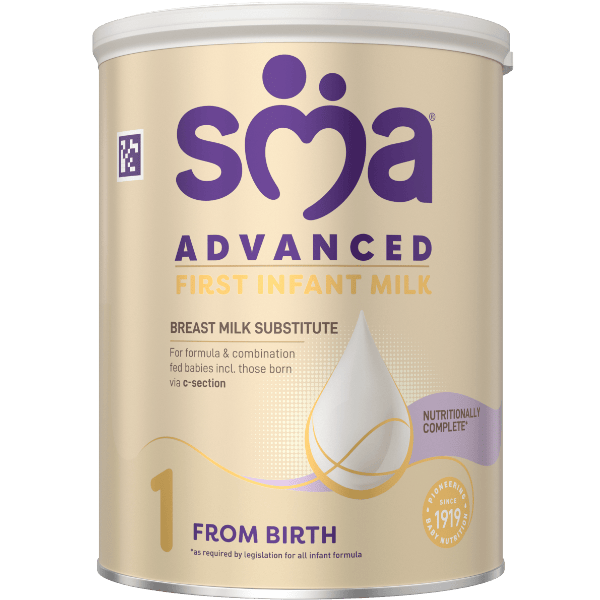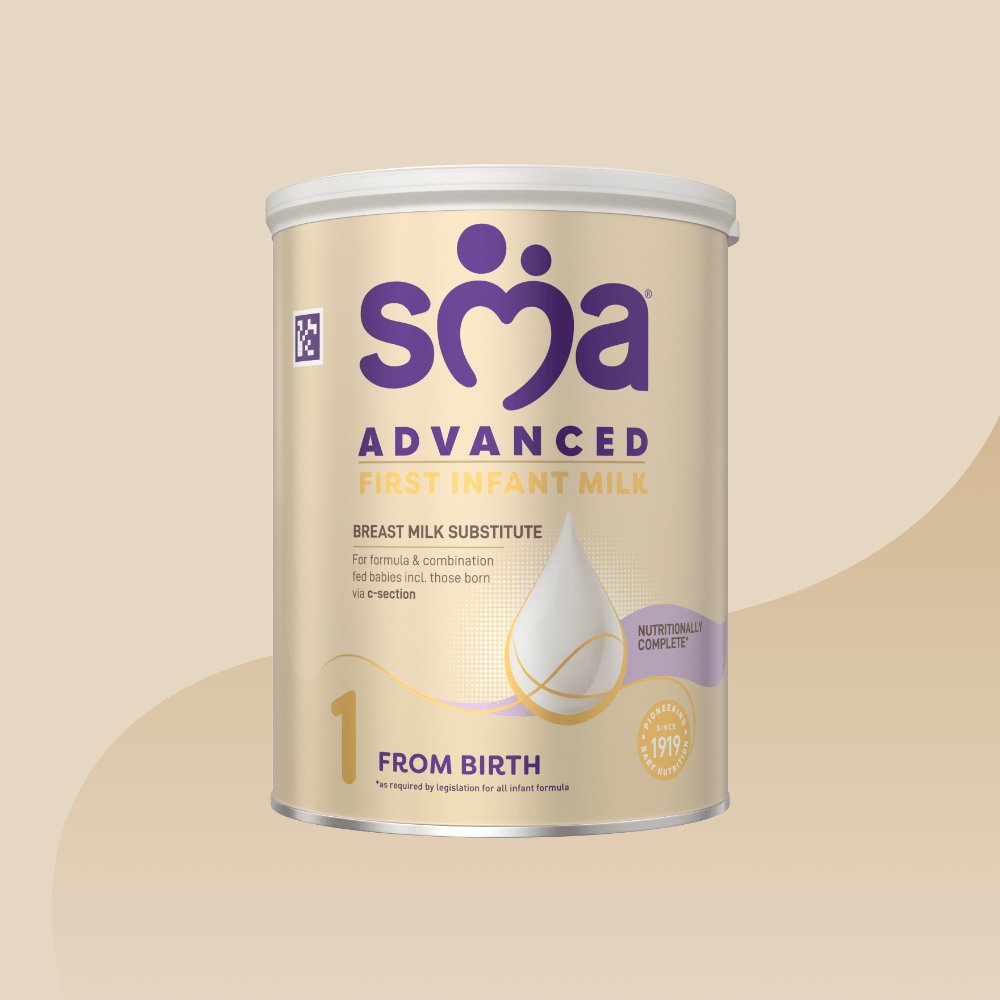SMA® ADVANCED First Infant Milk
A nutritionally complete* infant milk suitable from birth, it can be used for infants who are not being breastfed or who are being combination fed.
Comparison chart
| SMA® ADVANCED First Infant Milk | Aptamil ADVANCED First Infant Milk12-13 | |
|---|---|---|
| Contains latest breakthrough in infant nutrition - a unique 5-HMO Complex (2’FL, DFL, LNT, 6’SL and 3’SL) | ||
| Easy-to-digest, 100% whey dominant, partially hydrolysed protein | ||
| Nutritionally complete |
Clinical evidence
A randomised control trial suggests that high intakes of protein in early life may increase the risk of obesity in later life.19
Rapid postnatal weight gain can result from a high intake of growth-enhancing nutrients, such as protein, in the infant diet. Evidence from the Childhood Obesity Project study20, a large independent randomised controlled trial, suggests that higher protein intakes increase plasma and tissue levels of insulin-releasing amino acids, and of insulin and insulin-like growth factor, thereby increasing weight gain and adipogenic activity.20-22
*As required by the legislation for all infant formula
**At 6 months vs control
†Secondary outcome
Data cards

Download the powder format data card
Product details

SMA® ADVANCED First Infant Milk Powder Formula
800g Powder
The scoop is provided under the lid. It can be stored in suspension inside the can.
Birth - 12 months
| Approx. age of baby | Approx. weight of baby | Preparation for single feeds | Cooled, freshly boiled water | Feeds in 24 hrs |
|---|---|---|---|---|
| ||||
| kg | Level scoops | ml | ||
| Birth – 2 weeks | 3.4 | 3 | 90 | 6 |
| 2 – 4 weeks | 3.7 | 4 | 120 | 6 |
| 4 – 8 weeks | 4.2 | 4 | 120 | 6 |
| 2 months | 5.3 | 5 | 150 | 5 |
| 3 months | 6.1 | 6 | 180 | 5 |
| 4 months | 6.7 | 6 | 180 | 5 |
| 6 months | 7.6 | 8 | 240 | 4 |
| 7 – 12 months | - | 7 | 210 | 3 |
| Approx. age of baby | Approx. weight of baby | Preparation for single feeds | Cooled, freshly boiled water | Feeds in 24 hrs |
|---|---|---|---|---|
| ||||
| lb | Level scoops | fl. oz. (approx) | ||
| Birth – 2 weeks | 7 ½ | 3 | 3 | 6 |
| 2 – 4 weeks | 8 | 4 | 4 | 6 |
| 4 – 8 weeks | 9 ¼ | 4 | 4 | 6 |
| 2 months | 11 ¾ | 5 | 5 | 5 |
| 3 months | 13 ½ | 6 | 6 | 5 |
| 4 months | 14 ¾ | 6 | 6 | 5 |
| 6 months | 16 ¾ | 8 | 8 | 4 |
| 7 – 12 months | - | 7 | 7 | 3 |
This table is a guide only; a baby may need more or less than the volumes stated. Caregivers should consult their healthcare professional if more advice is needed. Remember, a baby should be fed on demand. Mix 1 scoop of powder to 30 ml (approx. 1 fl. oz.) of water. 1 scoop = 4.4 g Approx. 181 scoops per can.
- Do not add extra powder or water to make the feeds stronger or weaker and do not press powder into scoop. Using too much or too little powder can make your baby ill.
- We recommend preparing each feed in individual bottles when required.
- For hygienic reasons, discard unfinished feed in the bottle as soon as possible.
- For older babies, made-up formulae can be added to food.
- Do not alter or add to formulae unless medically directed.
- Do not warm feeds in a microwave, hot spots may occur and cause scalding.
- Remember, cows’ milk should not be used as a drink during the first year.
Preparation
How to prepare the baby's feed - powder
While this product is made under strict hygienic conditions, it is not sterile. Failure to follow instructions may make your baby ill.
- EFSA Panel on Dietetic Products, Nutrition and Allergies (NDA). (2014). Scientific Opinion on the substantiation of a health claim related to zinc and normal function of the immune system pursuant to Article 14 of Regulation (EC) No 1924/2006. EFSA Journal, 12(5), 3653.
- Mora J, et al. Vitamin Effects on the Immune System: Vitamins A and D Take Centre Stage Nat Rev Immunol 2008; 8(9): 685–98.
- EFSA Panel on Dietetic Products, Nutrition and Allergies (NDA). (2015). Vitamin C and contribution to the normal function of the immune system: evaluation of a health claim pursuant to Article 14 of Regulation (EC) No 1924/2006. EFSA Journal, 13(11), 4298.
- Based Infant Formulas. Int J Pediatr 2018; 2018: 4969576.
- Bosheva, M., Tokodi, I., Krasnow, A., Pedersen, H. K., Lukjancenko, O., Eklund, A. C., Grathwohl, D., Sprenger, N., Berger, B., Cercamondi, C. I., & 5 HMO Study Investigator Consortium (2022). Infant Formula With a Specific Blend of Five Human Milk Oligosaccharides Drives the Gut Microbiota Development and Improves Gut Maturation Markers: A Randomized Controlled Trial. Frontiers in nutrition, 9, 920362. https://doi.org/10.3389/fnut.2022.920362
- Victora CG, et al. Lancet 2016; 387: 475–90.
- Kunz C. Adv Nutr 2012; 3(3): 430S–9S
- Bode L. Glycobiology 2012; 22(9): 1147–62.
- WHO Multicentre Growth Reference Study Group. Acta Paediatr Suppl 2006; 450: 76–85.
- Baird J, et al. BMJ 2005; 331: 929.
- Kramer MS, et al. J Pediatr 2004; 145: 600–5.
- SMA® ADVANCED First Infant Milk datacard. Available at: https://www.smahcp.ie/formula-milk/advanced-first-infant-milk (accessed March 2023).
- SMA® First Infant Milk datacard. Available at: https://www.smahcp.ie/formula-milk/sma-first-infant-milk (accessed March 2023)
- Aptamil Advanced First Infant Milk datacard. Available at: https://www.nutricia.co.uk/hcp/products.html (accessed March 2023)
- Aptamil First Infant Milk datacard. Available at: https://www.nutricia.co.uk/hcp/products.html (accessed March 2023).
- HiPP Organic First Infant Milk datacard. Available at: https://www.hipp4hcps.co.uk/fileadmin/media_hcp/pdf/HiPP_organic_infant_milk_powder_datacard_030320.pdf (accessed May 2020).
- Cow & Gate First Infant Milk datacard. Available at: https://www.nutricia.co.uk/hcp/products.html (accessed March 2023).
- Piccolo Organic First Infant Milk. Available at https://www.mylittlepiccolo.com/milk/first-infant/ (accessed March 2023)
- Totzauer M et al., Obesity 2018;26(7):1023-10
- Koletzko B, et al. Am J Clin Nutr 2009; 89: 1836–45
- Kirchberg FF, et al. J Clin Endocrinol Metab 2015; 100(1): 149–58
- Weber M, et al. Am J Clin Nutr 2014; 99
IMPORTANT NOTICE:
We believe that breastfeeding is the ideal nutritional start for babies and we fully support the World Health Organization’s recommendation of exclusive breastfeeding for the first six months of life followed by the introduction of adequate nutritious complementary foods along with continued breastfeeding up to two years of age. We also recognise that breastfeeding is not always an option for parents. We recommend that healthcare professionals inform parents about the advantages of breastfeeding. If parents choose not to breastfeed, healthcare professionals should inform parents that such a decision can be difficult to reverse and that the introduction of partial bottle-feeding will reduce the supply of breast milk. Parents should consider the social and financial implications of the use of infant formula. As babies grow at different rates, healthcare professionals should advise on the appropriate time for a baby to begin eating complementary foods. Infant formula and complementary foods should always be prepared, used and stored as instructed on the label in order to avoid risks to a baby’s health.





